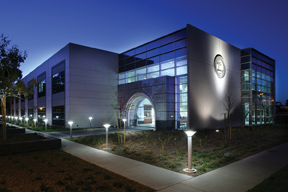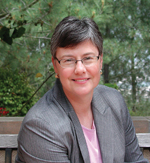On ground or online, higher education is raising adults’ career paths
Private nonprofit universities are picking up steam while state schools feel the heat

By Kris Grant
The fall semester started at San Diego State with a student and teacher rally to protest state budget cuts — $35 million at SDSU — resulting in fewer classes, lecturers and forced furlough days for professors.
This year the state slashed $584 million in funding for schools in the California State University system, including San Diego State and Cal State San Marcos. At the same time, students saw tuition at these schools rise 30 percent over the past four months.
The higher-fees-and-fewer-classes scenario (and 22,000 turned-away students in the university system) also placed greater demand on the community college system, where available classes filled quickly.
Meanwhile, Dr. Eileen Heveron, who was named provost of San Diego-based National University this July, reports that, “We’re having a very good year.”
Heveron is the first to acknowledge that education has indeed changed dramatically in the past 10 years.
“And the pace of change has accelerated over the past three,” she adds, attributing the rise in enrollment at private universities on the workplace’s preference for degreed individuals, either as new hires or promotions.
True, the student populations served by California’s university and state university systems and local private nonprofit universities are decidedly different, with the state focusing mostly on the 18 to 22 years age group, while the average age of National University’s students hovers around 28 to 32 “and we have many students much older,” adds Heveron.
But that’s part of the point. The face of education is changing across the nation and in San Diego. It’s getting older.
“It’s a big marketplace,” says Heveron, who notes the presence of several other private universities now on the San Diego landscape. “The shifts toward older adults pursuing higher education has been occurring over many years; it’s been accelerating over the past three years.”
At the core of the need for higher education for working adults, says Heveron, has been a societal shift toward ever-higher expectations from employers. “Over time, a high school diploma or an associate of arts degree doesn’t necessarily get you a job,” she says. “Now it often takes a bachelor’s and a master’s to move ahead. And as a result there is a much larger appetite for obtaining education across any demographic or age group.”
National University now has 28 campuses throughout California and one in Nevada with six campuses in San Diego and five additional campuses on local military bases. The university offers 100 undergraduate and graduate degrees and 22 teacher credential and certificate programs.
A leader in online education, National University offers more than 50 graduate and undergraduate online degree programs and more than 1,200 courses online.
Welcome to the
Virtual Classroom

Heveron says the school offers two masters of business programs that are available totally online. “It’s a virtual classroom,” she says. “The move to online has been going on for the past two years. It has been a major shift across the country with colleges and universities.”
Heveron says that more and more of National’s students are taking at least one or two courses online. “They have to spend the same amount of time on a subject no matter how it’s taught,” she says. “They can’t get by thinking they’ll go in on a Sunday night, read the information and pass the test on Monday.”
She says another trend that is proving very popular with National students is hybrid courses. “They go one night a week to a classroom where they can interface with fellow students and the other night of the week do online class work. It’s a neat way to go to school and you don’t have to fight the traffic.”
What most older students don’t have is time, says Heveron. “But they do have plenty of stress – jobs, family and finances. And so we’re always looking for opportunities to make access easy, and make getting a degree an exciting experience. We try to make all the details go away. For instance, we make it easy to apply online. There’s no need to have to traipse around with gobs of paper, and our students don’t have to stand in one more line.
“We’re always finding new ways to make things easier. We have an admission and a student concierge in our student center. And we’re soon going to add texting and chat to our Website.”
Still, students have their pick of more and more on-ground classrooms in San Diego County, most of them in office building settings. Private nonprofit universities with campuses in San Diego include the University of Phoenix (four in San Diego plus two in Imperial County); Brandman University (formerly Chapman), University of Redlands, and University of LaVerne, all of which offer undergraduate and graduate business degrees.
Arming Entrepreneurs with MBAs
After deciding he had had it with “the cubicle world,” Damien Devine turned to the University of Phoenix to help him achieve a childhood dream of establishing a restaurant and catering business featuring his patented “spaghetti sandwich,” which he has named the torpasta. “It was my childhood remedy to a messy spaghetti sandwich to place the spaghetti in a hollowed-out torpedo roll,” he says. Armed only with a bachelor of arts in literature from UCSD, Devine knew he needed a business background.
Devine received his degree in 2001, attending classes a couple of nights a week and working in a restaurant and doing sales for an alarm company during the day.
Devine said his instructors were helpful in providing advice, including test marketing his product, which he did. Devine’s business is now seven years old, has an expanded menu of 25 items, has secured nearly 200 positive “Yelp” reviews and was voted the top sandwich shop by Channel 10 News’s A List for the past two years. Now Devine is looking to franchise his business.
In the MBA classes, Devine said he was graded on both individual and group projects. “You combine efforts to put together a presentation or a paper. At first, I thought the group thing was a turn-off but I quickly realized it’s very real world and you need to learn how to interact,” he says. “You find strengths and weaknesses in different people in groups; in the real world it’s really like that. You’re forced to work within a group and not everyone has the same strengths. But in the end that becomes a benefit.”
John Slatinsky thought he had retired after 34 years in public education where for the last five years he was principal of Cerritos High School in Los Angeles, voted one of the top 100 high schools in the United States. Then he began doing adjunct work at Chapman, teaching one night a week in educational leadership. Now the campus director of Brandman University’s San Diego campus in Mission Valley, Slatinsky says it’s a joy to get up in the morning and come to work, where he’s developing programs that work for both his students and the community. Brandman (formerly Chapman University; Chapman retains its name for its main campus in Orange County) now has 25 “sub-campuses” from San Diego to the state of Washington.
The San Diego campus has 15 classrooms and “we’re looking for more space,” says Slatinsky. The second fall quarter starts in mid-October. At Brandman, there are five terms per year. Brandman currently has 360 students enrolled in San Diego; 85 are new to the university.
Setting up programs at schools and prisons
One type of initiative that Slatinsky is launching is “co-hort” programs, in which classes are conducted in conjunction with schools. Santee School District anticipates about 20 to 25 students seeking master’s degrees in the East County-based setting and San Diego Unified has signed up 21 on Brandman’s campus. There are about 65 additional “walk-in” students who will be invited to join these sessions.
Slatinsky has seen Brandman double its enrollment in the past year, which he attributes to the tough economy. “Many students are pursuing degrees to help them in ‘career lattering,’ moving from one position to another within the same corporation.”
Some corporations have tuition reimbursement, but there is a cap; several corporations that do offer that limit it to acertain amount of money per term, Slatinsky said.
Each university has its pluses and minuses, says Slatinsky. “Each person has to look at the positive and negative aspects of a school,” he says. “We offer programs that are on-ground and we’re expanding our online courses. We’re transitioning to on-ground for two hours and 45 minute classes and the other two hours and 45 minutes online.”
At Brandman, a full-time student takes two subjects per night with courses running nine weeks. Slatinksy says the average age is mid-30s, “But we have a person in his early 60s who is retraining for a new career. And he’s doing very very well, on focus and will transition out of here into a new career in human resources.”
At Brandman, the most popular courses are in education, special education and credential degrees. The school has student teaching placements with all 42 districts in San Diego County and also offers programs in marriage and family therapy.
Slatinsky says the only way to figure out what the community wants is to go out and talk with people and do lots of networking. The university offers a criminal justice curriculum and now Slatinsky is talking with correctional officers at Donovan State Prison. “Their officers want to get degrees that help them advance their careers. And we’re seeing a lot of students who have been laid off in San Diego County who want degrees in criminal justice to become more employable.”
Learning while learning
Like National University, Brandman recognizes there is a difference between an 18-year-old college student and an older student who has family responsibilities, a job and a car payment,” Slatinsky says. “The second focus we have here is that what the student learns in class tonight is something they can take on the job and implement tomorrow.”
When a prospective student comes to Brandman, they get an enrollment coach, Slatinsky says. “Then after the first class they are transitioned to an executive coach who follows them for 18 weeks minimum. That’s a free service to our students.”
Kim Urban started work on her masters in human resources at Chapman University in September 2007. She’s been attending class one night a week and will have her degree by the end of the year. By day, Urban works for a California workers comp insurance company in benefits analysis. “Chapman made it really easy for me, just one night a week from 5:30 to 9:30,” she says. “A lot of people thinks that’s easy but then you have tons of schoolwork that’s due the following week.”
“I’d like to go into management with the company I’m at now but we’ll see,” adds Urban. “I want to managed, take control of projects and deliver to my executive team. It’s a lot of work but if people have the ambition and the want, going back to school for a masters is a very rewarding feeling. And the people you meet are phenomenal. I get e-mails and phone calls returned quickly. The teachers are very much there for the students.”
One thing that unites all the local schools is the economy and current events. “When gas went up to nearly $5 a gallon a year back, we saw a surge in our online classes,” says National’s Provost Heveron.
“Now we’re bracing for the swine flu.” z
